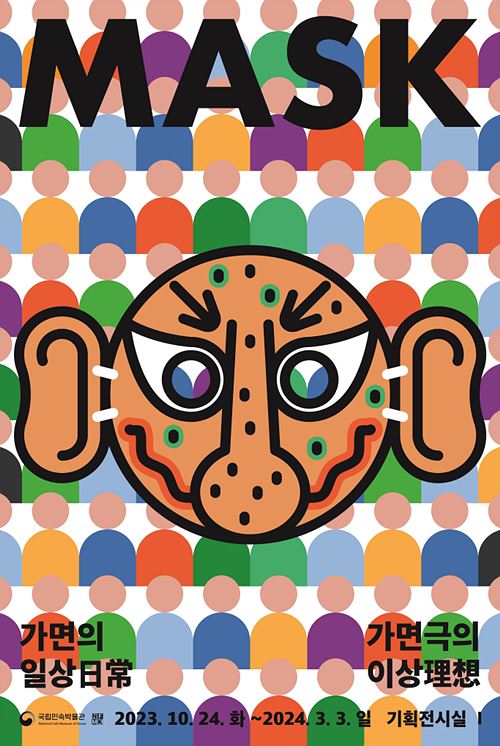Exhibitions
| Title | Mask: The Everyday Use of Masks, the Ideal of Masked Plays | ||||||||||||
|---|---|---|---|---|---|---|---|---|---|---|---|---|---|
| Period | Oct 24, 2023 - Mar 3, 2024 | ||||||||||||
| Venue | Special Exhibition Hall 1 at National Folk Museum of Korea | ||||||||||||
|

The National Folk Museum of Korea presents the special exhibition titled Mask: The Everyday Use of Masks, the Ideal of Masked Plays, introducing the desires encapsulated within the masked plays-a shared performing arts culture of Korea, China, and Japan.
 Prologue- The Everyday of MasksWe don masks. By doing so, we can conceal our true identities. Yet, paradoxically, it's often behind such veils that we reveal our most genuine feelings and desires. Why is that? Historically tools of rituals and entertainment, masks have evolved in contemporary times into communication forms like emojis, camera filters, and artificial intelligence (AI) avatars, each representing different facets of ourselves. Occasionally, even the very platforms of social media that seem to unveil our deepest feelings and dreams serve as masks. In such ways, masks have become a staple in our daily lives. Part 1. Different NarrativesMasked plays are dramas in which performers wear masks. Some argue that masks are nothing more than facades, and that masked plays are, in essence, mere performances. However, watching one might spark the thought: does wearing a mask make my portrayal any less genuine? Could it be that the sentiments expressed behind a mask are those too raw, too true, to be shown otherwise? Perhaps they encompass the authentic happiness we all chase? At their heart, aren't masked plays tales of souls seeking joy?
In the masked plays of the three East Asian countries-Korea, China, and Japan-there's an underlying commonality in their origins and evolution. Yet, they diverge subtly, much like our distinct faces, languages, and cultures. These plays satirize society, stir emotions with heroic tales, and greet the dawn with dances that mimic the divine. As we listen to the varied voices from behind these masks, we come to understand the genuine yearnings they harbor: unguarded confessions, dreams of heroism, and prayers offered to the divine, all expressed from behind a mask. 
Part 2. Unified DesiresMasked plays reflect the collective spirit and identity of a community. Each culture's rendition of these performances reveals a unique worldview. In Korea, the masked play blurs the boundary between audience and performers, creating a shared, open experience. The setting for Chinese masked play pays homage to heroes, akin to a celebratory red carpet. Meanwhile, the Japanese version transforms the stage into a shrine, honoring deities. Despite these distinctive backdrops and stories, the core desires resonating within these plays are surprisingly universal. They capture dreams of prosperity, bountiful harvests, and abundant catches of fish and game. Moreover, there's a shared hope for protection against illnesses and misfortunes. Consequently, the masked plays from Korea, China, and Japan often revolve around themes of prosperity, and universally echo narratives that aim to ward off evil and attract good fortune.
 Part 3. Faces of DiversityTo many, especially those in the West, the faces of individuals from Korea, China, and Japan might seem indistinguishably similar. Yet, a closer look at the masks of these three countries reveals an intricate tapestry of distinct features. Though each country has different languages, they find unity in Chinese characters. Their unique masked plays, while distinct, resonate on an emotional level across borders. As one observes the nuances in faces and expressions, it becomes evident that beauty lies not in their division but in celebrating the rich diversity they represent.
 Materials
|
|||||||||||||
| Date | 2023-10-27 | ||||||||||||
| 이전글 | MAEDEUP |
|---|---|
| 다음글 | The Blue Dragon |









